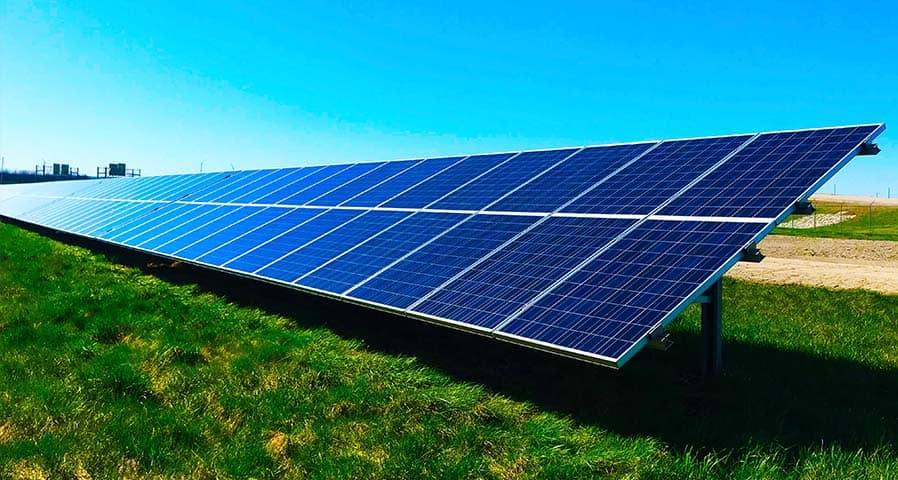Daylighting Controls & Daylight Savings: Optimizing Natural Light Through the Changing Seasons
Studies have shown that natural lighting has proven to improve workplaces by helping employees be more comfortable and efficient. As…

Installing solar panels in a home or commercial building lowers utility bills and conserves energy. However, solar panel fabrication plays a role in its effectiveness. Understanding the differences between the various types of solar panels can help you make the right decision for your home or business.
Solar panel efficiency depends on the amount of sunlight reflecting on the panels’ surface. The reflected sunlight is transformed into electrical energy. Older solar panels have an efficiency rating of around 15%, but advancements in photovoltaic technology have increased efficiency to up to 22%. Some high-efficiency solar panels reach 23% efficiency.
Determining a solar panel’s efficiency depends on two factors, panel efficiency and photovoltaic (PV) cell efficiency.
PV cell efficiency refers to the silicon type and cell design. The cell layout, configuration, and panel size are the basis used to determine the total efficiency of the solar panel.
Cell efficiency refers to the maximum power rating determined under standard testing conditions.
Three types of solar panels are most commonly used in residential and commercial buildings. Here’s a brief look at each of the three types.
Monocrystalline solar panels are typically installed in larger commercial buildings and residences. These solar panels are often the most energy efficient.
Pros
Cons
Polycrystalline solar panels are constructed from silicon crystals melted together. However, using more silicon crystals does not create a more efficient solar panel. It’s why these solar panels are less expensive than monocrystalline ones.
Polycrystalline solar panels come with power settings ranging from 5W up to 250W and higher.
Pros
Cons
Thin-film PV cells are lightweight and easy to install. Unfortunately, these types of solar panels are the least energy efficient. The two primary benefits of these panels are their portability and flexibility.
Pros
Cons
Several factors impact solar panel efficiency, here’s a look at the common ones.
The inverter converts a direct current to an alternating current. Homes and commercial buildings run on AC power. Since most inverter’s conversion efficiency is between 97% to 99%, the energy loss is minimal.
Thermal cycling refers to how solar panels react to temperature changes. Panels expanding and contracting can lose some of their energy efficiency.
North-facing roofs rarely receive enough sunlight for solar panels. The best orientation is to install the panels on a south-facing roof. West and east-facing roofs are the next best option.
Environmental factors can impact solar panel efficiency. It’s something to consider before installing the panels on a commercial or residential building.
Solar panels function best when temperatures are around 77°F. Peak efficiency occurs between 59°F and 95°F. When temperatures climb higher, solar panel efficiency can decline.
Color also affects solar panel efficiency. While black can increase temperatures above optimal degrees, using dark blue, green, or patterns for the backdrop can increase efficiency.
Snow accumulating on the solar panels can decrease efficiency.
Wind can tear off solar panels, but it does not affect efficiency when the sun is shining.
Rain only affects solar panel efficiency when storm clouds block sunlight. However, rain can help keep layers of dirt and dust in place which does affect efficiency.
Solar panels are tested and can withstand most hailstorms. However, prolonged ones can damage solar panels.
Dust and grime will build up on solar panels, reducing efficiency. Regular cleaning will help prevent the issue.
Selecting the type of solar panels you need can be a daunting task, and it is just the start of your solar panel journey. You will also need to consider things like manufacturer, permitting, electrical upgrades, installation, and project management. Action Services Group has over 30 years of experience in electrical project management.
The Center for Sustainable Energy reports that the installation can cost, on average, between $15,000 and $25,000. It’s a large expense for commercial and residential building owners to consider.
Over time, you can recoup your initial investment, especially when it comes to energy savings.
Where you install the solar panels is key. Remember, you want to install the panels in a location receiving the most amount of sunlight. It’s also a good idea to examine your energy usage. Are you using enough to justify the cost of installing solar panels?
Installing solar panels can improve energy efficiency, and you have several types to choose from. If you have questions about solar panels or are ready to start a project, contact one of our experts today.
Call 610-558-9773, emailing [email protected] or schedule a call that fits your needs by clicking the button below.